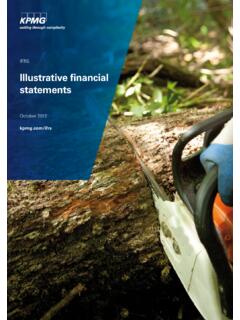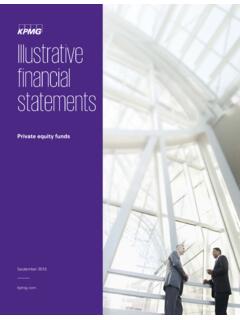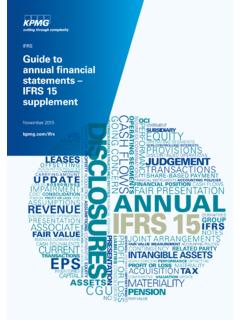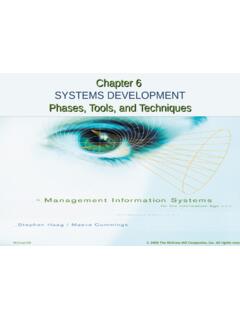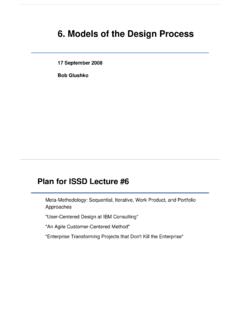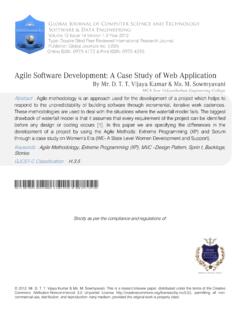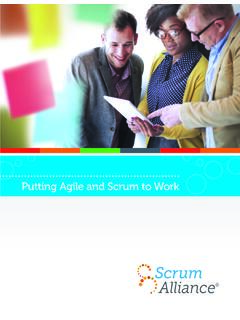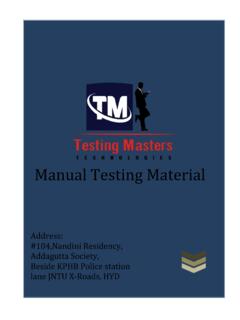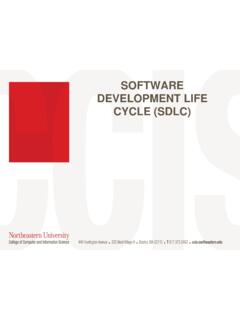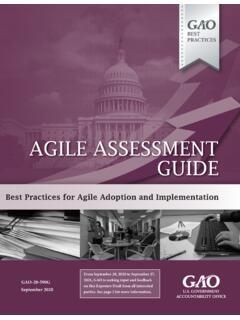Transcription of Agile Internal Audit - KPMG
1 Agile Internal Audit I 1 Agile Internal AuditWhite paper on working Agile within Internal Audit FunctionsPart I: Introducing working AgileJanuary 20192 | Agile Internal AuditAgile Internal AuditAgile Internal Audit I 3 Complex, dynamic and has summarized its international customer knowledge and experiences with Agile auditing in this (two-part) White 1 Provides insight into the history, the context and the added value of conducting Agile audits within 2 Provides practical guidelines to aid an IAF into applying the starting points of Agile auditing in the design of the IAF, in the planning and during the execution of the audits..are key words for the continuously changing organizational environment. Change is the only consistent factor and the number of changes is increasing rapidly.
2 This requires organizations to adapt an innovative way of working and mindset in order to remain successful. We have also seen the same necessary shifts taking place within the field of Internal Audit in recent years. From working in a reactive to a more proactive way, from giving assurance to providing advice and insight to organizations, but also an increasing number of Internal Audit Functions (IAF) started dealing with Agile . It started with auditing of Agile (IT) processes which later transformed into the IAF applying the Agile principles while planning and during the executions of audits. Some of the IAFs in the Netherlands are leading in applying the Agile principles in their work while others are still experimenting.
3 Agile approaches Impact of Agile on IAF Performing Agile audits Challenges and opportunities of Agile audits Case: Agile auditing by front-runners Agile Do s and Don ts Part 2 Part 1 Origin of Agile Traditional Waterfall vs Agile auditing Agile and Internal Audit Main Agile concepts Agile and the IPPF Agile Internal Audit Maturity ModelAgile Internal Audit I 34 | Agile Internal AuditOrigin of Agile Agile is a collective name for methods based on the principles of the Agile Manifesto. Originally it was used in software development . Today, it is being used in all functions of an organization including the second- and third line objectives of applying the Agile principles within an IAFs are: increasing Audit quality, short Audit cycles, more interaction with the auditee and providing insights.
4 Wicked Problems, Righteous Solutions by Peter DeGrace & Leslie Hulet Stahl deals with the Scrum approach and other Lean methods for software of Adaptive software development , Feature Driven development , and Dynamic Systems development Method (DSDM).Ken Schwaber & Jeff Sutherland present Scrum methodology for Business object development and implementation at the OOPSLA Programming starts with the Chrysler Payroll Project. Extreme Programming Explained : published by Kent Production System (TPS) becomes popular in production environments, the start of 'Lean' The New Product development Game of Hirotaka Takeuchi & Ikujiro Nonaka is published in the Harvard Business Review, with attention for the Rugby/Scrum approach within Agile Manifesto is Schwaber & Mike Beedle publish the now famous ' Agile software development with scrum'.
5 The start of the projecs Agile Unifie Process (AUP) Scott Ambler, Open Unifie Process (OpenUp) eclipse project, Essential Unifie Process (EssUP) Ivar Jacobson. Implementing Lean software development by Mary and Tom Poppendieck in which Kanban is introduced. A Practical Guide to Distributed Scrum is published by Elizabeth Woodward, Steffan Surdek & Matthew - 19891990 - 19992000 - 2009 Agile Internal Audit I 5 Agile application in organizational units other than ITFrom improvement projects outside the line to continuous improvement within the 'products'First pilots in the field of Agile auditing in the Netherlands2010 - presentRecent developments & futureAgile application for the entire organization1) Agile within the 1st Line OfDefense2) Agile within the 2nd LOD( risk, compliance)3) Agile Internal AuditIn the future, a large number of IAFs will apply Agile auditing with varying degrees of maturity (see also the Agile IA Maturity Model on page 10-11) Agile (Auditing)
6 Timeline6 | Agile Internal Audit 2019 KPMG Advisory founders of the Agile methodology trace back to the last century, but their recognition and application is still under Royce introduced the waterfall method in 1970, mainly to show how it should not be done. He was in favor of the do-it-twice approach, in which the focus is on splitting the project is small parts and acting on these. Paradoxically, since then most of the projects have been executed according to the waterfall method. ( Internal ) audits are also carried out on the basis of the waterfall method. An Audit exists of the following six phases: planning, preliminary research, fieldwork, reporting, evaluation and follow-up. Often, and based on the current interpretation of the Internal Audit standards, the next step phase will only be started when the previous one is 2240 requires an approved work program prior commencing the field work.
7 At the same time this Standard also offers space for adjustments to the working program during this field work phase of the Waterfall vs. AgileWhen performing an Agile Audit , this will be the rule rather than exception. This requires an Audit manager who approves all changes to the working program (and the reprioritization on the backlog). Working Agile is certainly not something that all organizations should apply. In this respect, the environment and culture of the organization must always be taken into account. It is important to realize that the current waterfall method is not necessarily the best solution for the IAF. For this reason, it is valuable to get acquainted with and to open up to newer ways of thinking and working such as Agile publication shows that in addition to the six Audit steps, which is applied by almost all IAFs, the integration of Agile methods can help increasing the added value of the IAF and the Internal control of organizations.
8 Distinctive features of Agile compared to the waterfall method are: interactive, flexible and learning ability. 2019 KPMG Advisory neBuildWaterfallAgile Internal Audit I 7 2019 KPMG Advisory and Internal AuditThe Agile philosophy is based on four principles: Individuals and Interactions over processes andtools Working software is more important thancomprehensive documentation Customer collaboration over contract negotiation Responding to change over following a planAgile Internal Audit is the mindset and method that an IAF uses to focus on the needs of stakeholders; accelerate the Audit cycles, providing timely insight and reduce the waste of resources. By applying an Agile method, the productivity and added value of the IAF can be increased and the lead time of an Audit can be key features of an Agile Internal Audit : Other mindset of the auditors The approach of the Audit is flexible The use of day starts Increased involvement of the auditee Continuous coordination of the product (report) Applying Agile principles that are relevant 2019 KPMG Advisory a flexible way to make a product.
9 Working in multidisciplinary teams that deliver working products in short sprints, with a fixed length of one to four a management philosophy in the field of operations management that aims to realize maximum value for the customer with as little waste as an iterative method to get wishes and demands above the surface and to continue to meet the ever-changing , Lean and Agile , what does it mean?Value creation for the client by focusing on the ( Agile ) optimization of the method by welcoming and multidisciplinary teams as a basis for the added iterations as an aid for timely adjustments in an and dynamic Internal Audit Planning as a result of continuous risk s Agile IA Manifesto12345 2019 KPMG Advisory | Agile Internal AuditKey Agile conceptsTo aid in developing a better picture of Agile auditing, a number of concepts from Agile are explained backlogAn overview which is constantly updated with a dynamic determination of the Audit (sub)topics.
10 This offers flexibility compared to a static Internal Audit Plan (for example, one year). The items on the Audit backlog are abstract regarding the scope, the process and the timing. When the IAF and its stakeholders ( the board or the AC) redefine the Audit needs, the item will be placed higher on the backlog until it is ready to be audited. Drivers within this process include the continuous risk analysis, the needd of stakeholders but also elements such as the date of the last Audit in order to obtain a periodic cover of the total Audit of Ready (DoR) An item on the Audit Portfolio Backlog is 'DoR' when the IAF and the stakeholders agree on what will be audited; about what the Audit should achieve, the expected added value and the requirements for the SprintsDuring the execution of the Audit , the item is unlisted from the backlog and the various scope elements will be divided into defined auditable subjects, so-called sprints.

